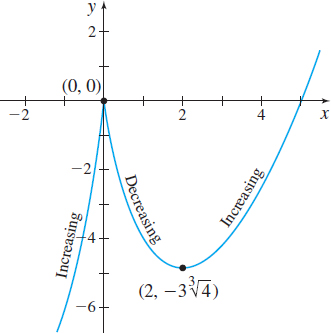EXAMPLE 2Using the First Derivative Test to Find Local Extrema
Find the local extrema of f(x)=x2/3(x−5).
Solution The domain of f is all real numbers and f is continuous on its domain. f′(x)=x2/3+(23)x−1/3(x−5)=3x+2(x−5)3x1/3=53(x−2x1/3)↑Use the Product Rule.
Since f′(2)=0 and f′(0) does not exist, the critical numbers are 0 and 2. The graph of f will have a horizontal tangent line at the point (2,−33√4) and a vertical tangent line at the point (0,0).
286
Table 4 shows the intervals on which f is increasing and decreasing.

Figure 34 f(x)=x2/3(x−5)
| Interval | Sign of x−2 | Sign of x1/3 | Sign of f′(x)=53(x−2x1/3) | Conclusion |
|---|---|---|---|---|
| (−∞,0) | Negative (−) | Negative (−) | Positive (+) | f is increasing |
| (0,2) | Negative (−) | Positive (+) | Negative (−) | f is decreasing |
| (2,∞) | Positive (+) | Positive (+) | Positive (+) | f is increasing |
By the First Derivative Test, f has a local maximum at 0 and a local minimum at 2; f(0)=0 is a local maximum value and f(2)=−33√4 is a local minimum value.